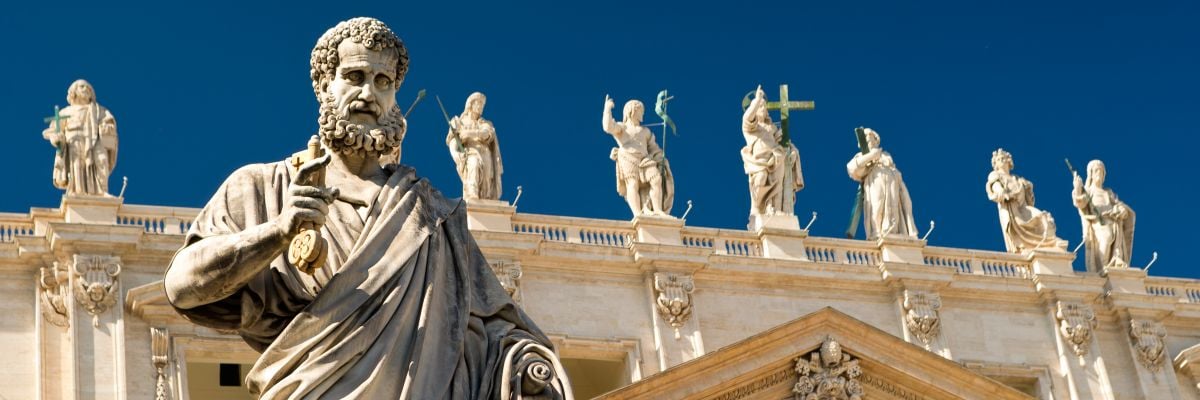
One of the key discoveries in Scripture that led to my conversion to the Catholic faith was the realization that Peter is the “rock” that Jesus speaks of in Matthew 16:17–19. I can still remember when, one afternoon in August 1991, I was reading a Catholic book quoting the passage and my eyes fell on a structural feature of the text that required me to revise my views on it. Up to this point, I had always said to myself that Catholics were wrong in supposing Peter to be the rock on which Christ would build his Church. That rock, I held, was the revelation of Jesus’ identity as the Messiah. In the passage, I thought, the “small stone” Peter (petros) was being contrasted with the “large rock” (petra) of Jesus.
What I did not know at the time was that the linguistic argument made by some Protestants regarding the Greek text’s use of the terms petros and petra was off base. There had been a distinction between the meanings of these terms in some early Greek poetry, but that distinction was gone by the time of Jesus. In the first century, when Matthew’s Gospel was composed, the two terms were synonyms (cf. D. A. Carson’s treatment of the passage in The Expositor’s Bible Commentary, published by Zondervan).
I also had not devoted sufficient attention to the fact that Jesus and Peter did not speak Greek in everyday language, but Aramaic. (Greek was the language of commerce in first century Palestine; Aramaic was the language of everyday life.) Behind the Greek text of Matthew 16:17–19 there was an Aramaic conversation, and in the conversation there would have been no distinction between the terms representing petros and petra. In both cases, the same word—kepha (from which we get “Cephas”)—would have been used. Hermeneutically, one should read a translation text in harmony with the language that underlies it since the translation is simply a means to understanding what originally was said. Consequently, Jesus’ statement in Aramaic—”You are kepha and on this kepha I will build my Church”—should be decisive for our interpretation.
I knew enough back in 1991 to know that the interpretation of the rock as the revelation of Jesus’ identity was not entirely secure. It was a general deduction based on the themes being talked about in the passage, not a specific deduction based on the structure and grammar of the passage. Then, as my eyes went over the text once again, I suddenly noticed a structural feature of the passage that tipped the balance in favor Peter being the rock. Instantly, I knew I had to do a major theological re-evaluation.
For some time, I had recognized that if Peter was the rock then he would be the head apostle and thus, when Jesus returned to heaven, the earthly head of the Church. That would make him, in essence, a pope. If Catholics could be right about Peter being a pope, they might be right about other things—about everything. And so I would have to do a thorough re-investigation. When I did, I was forced to conclude the Catholic Church was right, and I became a Catholic.
After the initial flash of insight into Matthew 16:17–19, I did further study on it and noticed several structural features of the passage that required Peter to be the rock. Basically, Jesus’ speech to Peter consists of three statements. The first of the three statements is a clear blessing on Peter. Jesus says, “Blessed are you, Simon Bar-Jona!” The third is also a blessing: “I will give you the keys to the kingdom of heaven.” But if the first and third statements are blessings then the middle statement—”And I tell you, you are Peter”— taken in its immediate context, must be a blessing as well. Jesus thus is not contrasting and belittling Peter as a small, insignificant stone with the second statement. It, like the ones before and after it, is a blessing that builds him up.
I noticed that the structure of the three statements required Peter to be the rock. Each statement consisted of two parts: first a basic declaration and then a longer explanation which unpacked the meaning of the declaration. (The explanations also had two parts, an assertion followed by a contrast, but this need not detain us since it does not affect the fact that Peter is the rock.) Jesus’ first statement, “Blessed are you, Simon Bar-Jona!” is explained by “for flesh and blood did not reveal this to you, but my Father who is in heaven.” This is a reason why Simon is blessed. The third statement, “I will give you the keys of the kingdom of heaven” is explained by Jesus’ remarks on binding and loosing. The power to bind and loose is part of what it means to have the keys to the kingdom. That being the case, the second statement, “And I tell you, you are Peter” is explained by “and on this rock I will build my Church.”
No two ways about it. Peter is the rock.



